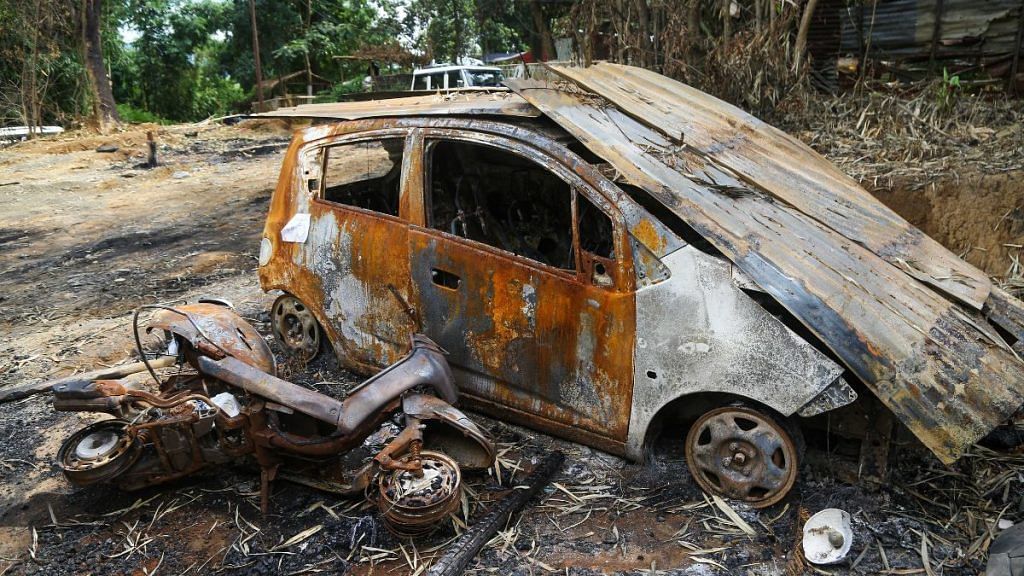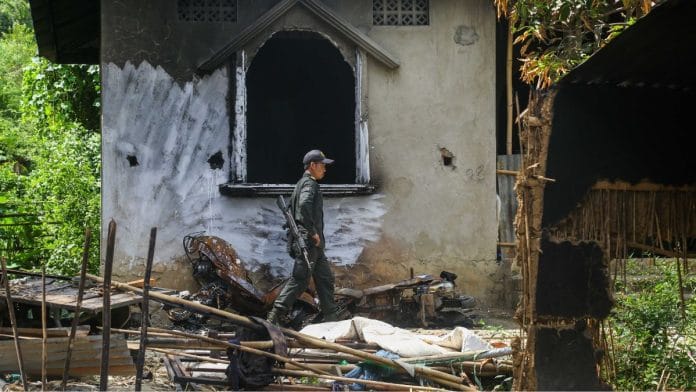Koutruk: Over ten kilometres from the highway, a narrow, rugged and stony road in the countryside winds through lush green rice fields, leading to Koutruk, a village in Manipur. The village stands on the border of the Meitei-dominated Imphal West and the Kuki area of Kangpokpi.
It is in this Manipur village where, allegedly, drones flying in from the hills dropped over 50 bombs on 1 September before the village came under firing and even an arson attack. The drone bombing, police sources said, went on for more than three hours before the Border Security Force, the Manipur Police, and the Central Reserve Police Force (CRPF), with its Mine Proof Vehicles (MPVs), brought the situation under control.
According to the police, it was the first time that security forces and civilians had come under attack from the high-tech drones that dropped Rocket Propelled Grenades (RPG) on them — which marked a “significant escalation” in the ongoing Manipur violence.
On that day, one woman, identified as Ngangbam Surbala (31), died of a bullet shot while her eight-year-old daughter sustained a bullet wound. Two security personnel and three civilians received injuries.
The signs of destruction by the drone bombing are evident in the village. Vehicles lie charred, a house is in ruins, and the grass looks scorched.
Kuki Inpi — the apex body of the Kuki tribes who live up in the hills — has denied the involvement of its people in the drone bombing.

In Koutruk, five village defence volunteers, armed with weapons such as single-barrel guns that they claim are licensed and walkie-talkies, stand guard at the village entry — their eyes on the hills. A few volunteers hide inside the trenches created by digging up the ground, ready to draw fire.
Around 3 pm on 1 September, locals started to hear the sound of drones flying overhead. However, they assumed the drones were for surveillance, which has been common in the area since the Kuki-Meitei clashes broke out in May last year.
“We were sitting in our bunkers when we heard the drone, but we thought it was for surveillance. But, soon, it started to rain bombs. We also heard gunshots. We started running for shelter. The first bomb fell on the ground and the second on our bunker,” a village defence volunteer in his twenties, who did not want to be named, told ThePrint.

He alleged that the drones dropped the bombs — something they had not seen before.
“We ran towards the fields to save ourselves as 50-60 bombs, one after another, rained down. It was the first time that we saw drones dropping bombs,” he said.
He further alleged that some people from the hills entered the village and set their vehicles and houses afire.
“There was firing, then drone bombing, and then people set our bunkers and houses on fire. From the top of the hills, they keep monitoring us, and they want to destroy our base,” he said.
The next day, on 2 September, drones dropped a few more bombs but, by that time, the security forces had taken charge of the area.
The Kuki Inpi has released a statement, saying, “The allegation that the Kukis use drones to drop bombs is completely false and unfounded. Our village volunteers only use camera drones for surveillance to monitor and gather information, adhering to international laws.”
Speaking to ThePrint, Indigenous Tribal Leader’s Forum (ITLF) leader Ginza Vualzong
said Kukis do not have sophisticated technology and have always used ‘pampi guns’ for self-defence.
Also Read: Around 9 ft & 24 kg with 8-10 km range, improvised rocket bombs emerge as new threat in Manipur
Drones made sorties in Manipur village

According to sources in the security establishment, the drones used to drop the bombs were assembled from its parts but sophisticated and good enough to carry a bomb weighing over 800 grams to 1 kg.
A second source said that on 1 September, several drones were spotted in the area. While some were for surveillance only, others dropped bombs.
The drones, the sources said, did sorties—dropped a bomb, went away and came back loaded.
“Some drones made several trips. It seemed like a systematic operation, not a random exercise of surveillance common in the area. If it was not systematic and planned, one or two drones would have been deployed. The battery life of drones is not that much, which means batteries were kept ready to be quickly replaced,” the source said.
Following the attack, Manipur Police carried out a search operation in two hill villages — Kharam Vaiphei and Pollen in the Kangpokpi district — and recovered gelatin sticks and a few weapons such as double-barrel guns. The police also recovered a drone, but it did not have a hook for loading bombs.
Afterwards, the police sought the assistance of an expert, a former IITian, to check the recovered drone. The drone was found to have been assembled — its receiver, controller, and spin fan were from different companies.
A mix of crude and factory bombs

According to sources in the security establishment, the bombs dropped were a mix of crude locally made ones and fine factory-made ones. The bombs, sources said, weighed 300-400 grams and were nine to 10 inches in size.
In a few bombs, the plastic body on the outside had “Kukiland” engraved on it and a hook to hang it on a drone, sources confirmed.
“While some of these bombs were the crude ones we have seen before, there were some fine bombs that could not have been made locally,” a source said.
Moreover, a paste-like explosive — not commonly used in crude, locally made bombs — was found in some bombs that fell but did not explode.
“In locally made bombs, a powder is used as an explosive — whether it’s TNT or any other explosive. But, in these bombs, a thick paste was used in the head of the RPG, which is much more potent,” a second source said. “The material used in making these bombs, the texture, the engraving, all this cannot be done locally,” the source added.
Also Read: Arson, stone pelting in Manipur’s Thoubal. Students want central forces, CM to go
Involvement of highly trained professionals

A third source in the security establishment said there is a big likelihood that “highly trained professionals” who are “technically sound” and have used such a technology in the past have played a role in facilitating this attack.
The source said neighbouring Myanmar, where the People’s Defence Force (PDF) is fighting the junta government, has reported similar aerial bombings in recent months.
“Such technology is available across the (Manipur) border — just a few kilometres away. When you see this technology, used in Myanmar, is now used here, it raises serious questions. It certainly is not organic,” the source said.
Operating across townships and regions, the PDF consists of armed groups that emerged around mid-2021 after the military organised a coup and displaced the elected government.
The PDF enjoys the recognition of the National Unity Government (NUG) — a government formed in exile in opposition to the junta.
The current military government considers both NUG and PDF “illegal and terrorist organisations”.
Anti-drone guns in Manipur village

Manipur is now investing in anti-drone technology to counter the threat.
The Army has transported anti-drone technology to the Manipur village of Koutruk — to the Kangchup area where the bombs dropped — and CRPF, BSF, ITBP, and Manipur Police have instructions to purchase.
“One has been placed in Koutruk. So now, after spotting a drone, it can be jammed. Moreover, we have asked the CRPF for three such anti-drone guns, and the BSF and the ITBP asked to buy some,” the source said. “The idea is to place at least eight to nine such guns in the fringe areas, in the buffer zones that are volatile,” the source added.
The security forces have also started conducting searches, combing operations and area domination exercises near the villages — in the hill area within five km of the villages.
“Earlier, we did it only in the fringe areas, but now, we are going deeper into villages. The searches have resulted in seizures, and we are also carrying out sensitisation programmes with the village defence volunteers to tell them that using such improvised explosives is against the law and can cause grave damage,” he said.
“We have been trying to tell them that escalation of this war will only bring more devastation for both sides,” he added.
(Edited by Madhurita Goswami)
Also Read: Kuki ex-serviceman who crossed Manipur buffer zone found dead. ‘Can’t even get his body,’ says son







It’s very unfortunate that well fabricated lies are being circulated in media without any fact check and again was link to Myanmar Drone bombing cases. Don’t fall for the lies that the Imphal valley people spread. And for your kind information, the Drone that drop the bomb was flown by Arambai Tenggol (militia/terrorist) of the valley people.
But the central government says that, any incidents like this doesn’t happen.